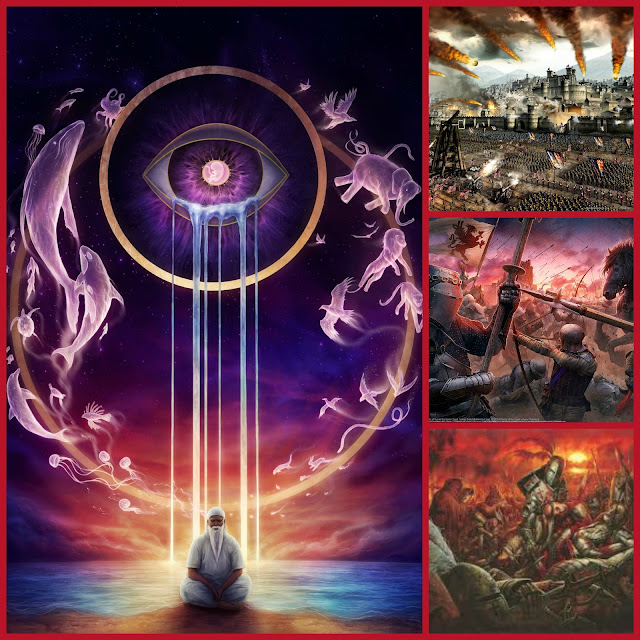Vanessa drips snot
I will always remember seeing Camelot for the first time – on TV one Saturday afternoon after playing rugby – and being amazed at one of the later scenes when Vanessa Redgrave is so emotional that her nose drips snot.I’d never seen an actor seemingly so “in the moment” before. It made Guenevere’s trauma seem raw, real and true – and I followed Vanessa Redgrave’s career thereafter, both on screen and, whenever I could, on stage. Her kind of deeply-felt acting in Camelot sometimes feels at odds with film musical conventions - at least in the 1960s. But the emotion is NOT at odds with the source material, TH White's glorious Once and Future King.
 |
| Vanessa Redgrave, as an emotionally exposed Guenevere |
In The Once and Future King, the whimsical mingles with the tragic in an unsettling and often teasing fashion. Although a musical comedy in form, the content of Camelot is not at all like Lerner and Loewe’s other major works: Brigadoon, Paint Your Wagon, My Fair Lady or Gigi. Lyric writer Alan Jay Lerner managed, I think, to pull off the weird mix of comedy and tragedy that TH White created in his 5 volumes of The Once and Future King.
Serious themes need serious performers
Although there are joyous (and bonkers) showstoppers (The Lusty Month of May or What Do The Simple Folk Do?) and comedy characters, like Lionel Jefferies as King Pellinore, many characters are about to die in battle as Camelot ends, the main relationships are doomed, the dialogue and lyrics contain discussions of Justice, War, Gender, Class and Society. (Thinking about Class in My Fair Lady or Gender in Gigi, I suppose all the best musicals are riddled with issues.) The themes of Camelot certainly require actors with serious credentials – Richard Harris, David Hemmings, Laurence Naismith, Franco Nero and Vanessa Redgrave were not known when they made the film for being song-and-dance performers.
 |
Franco Nero as Lancelot with knife to David Hemmings’s
Mordred
|
Guenevere and Lancelot eventually married….
Later “real-life” events, of course, proved that the potent sparks between Vanessa Redgrave’s Guenevere and Franco Nero’s Lancelot led to a lifelong friendship and love, as well as a son, Carlo. Vanessa and Franco eventually married in 2006, nearly 40 years after they first met on the set of Camelot. Meryl Streep speaks very eloquently about one of my all-time heroes in this link here.
 |
Eventually wed, nearly 40 years later, Vanessa
Redgrave and Franco Nero
|
I’m sure it was lyrics like the following that drew Vanessa Redgrave to star as Guenevere, lyrics that are simple but perfect for catching in your throat and cracking with emotion:
And now there's twice as much grief,
Twice the strain for us;
Twice the despair,
Twice the pain for us
As we had known before.
And after all had been said,
Here we are, my love,
Silent once more,
And not far, my love,
From where we were before.
Franco Nero as Lancelot and Vanessa Redgrave as Guenevere
From tender lyrics to Beano violence in Then You May Take Me To The Fair
Alan Jay Lerner had a very playful style with lyrics, most famously in My Fair Lady and the following example from Camelot is a good contrast to the above extract from I Loved You Once In Silence:
SIR LIONEL: Your majesty, let me tilt with him and smite him!
Don't refuse me so abruptly, I implore!
Oh, give me the opportunity to fight him
And Gaul will be divided once more!
GUENEVERE: You'll bash and thrash him?
SIR LIONEL: I'll smash and mash him.
GUENEVERE: You'll give him trouble?
SIR LIONEL: He will be rubble.
GUENEVERE: A mighty whack?
SIR LIONEL: His skull will crack.
The two filmed Camelots
I wonder whether Camelot will be more admired in generations to come and its over-wrought acting (with an abundance of disconcerting closeups) might be seen as psychologically penetrating. There is a 1982 made-for-TV filmed stage-version, which captures the SCORE of Camelot better than the film, but it does not beat the 1967 version for ART and DESIGN.
 |
| The Great Hall at Camelot, part of the Oscar-winning design |
Award-winning elements despite its flaws
I recommend watching Camelot. The film received 5 well-deserved Oscar nominations and won 3 for Music, Costume Design and Art/Set Decoration (other nominations were for Sound and Cinematography.) The film also received 6 Golden Globe nominations and won 3: Richard Harris as Actor, Frederick Loewe for Score and also with Alan Jay Lerner for the Song for If Ever I Would Leave You. The orchestration, the textures, the colours, the lighting - especially if you see a brightly-projected version or a restored DVD verson - are ravishing in conjuring a faux-medieval world. Director Joshua Logan stages some moments to linger long in the memory, for example the candlelit wedding, the early scenes in the snow and the aftermath of the jousting scene. There are unfortunately a few clumsy visuals, for example, when Arthur is soliloquizing after he first suspects his wife of being unfaithful, a shadow across his face looks like an erect penis…. A mischievous editor or cinematographer I wonder?
Don’t let it be forgot….Each evening, from December to December,
Before you drift to sleep upon your cot,
Think back on all the tales that you remember
Of Camelot.
Ask ev'ry person if he's heard the story,
And tell it strong and clear if he has not,
That once there was a fleeting wisp of glory
Called Camelot.
Where once it never rained till after sundown,
By eight a.m. the morning fog had flown.
Don't let it be forgot
That once there was a spot
For one brief shining moment that was known
As Camelot.



























